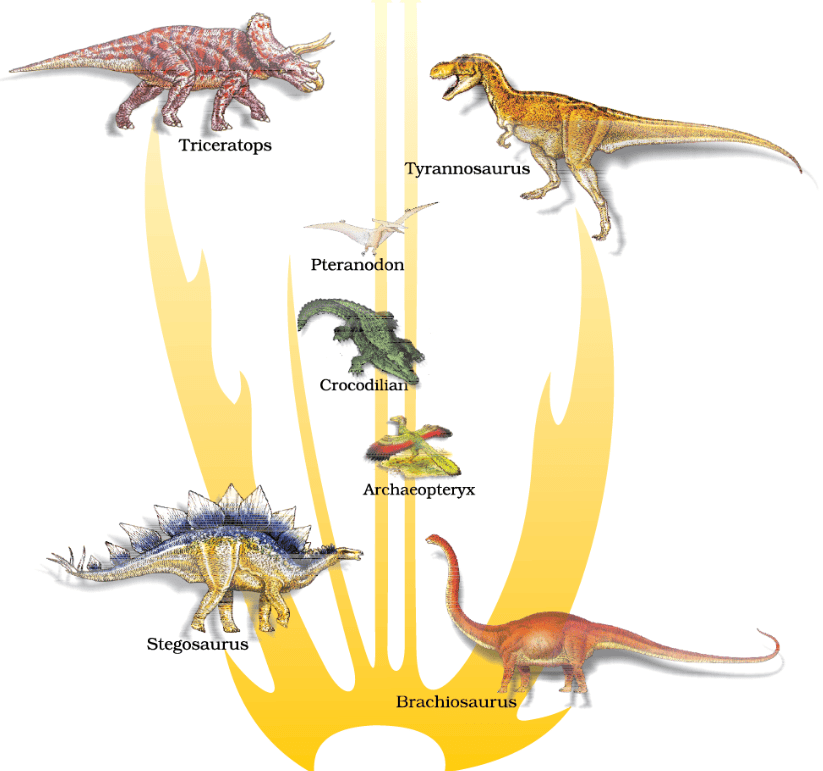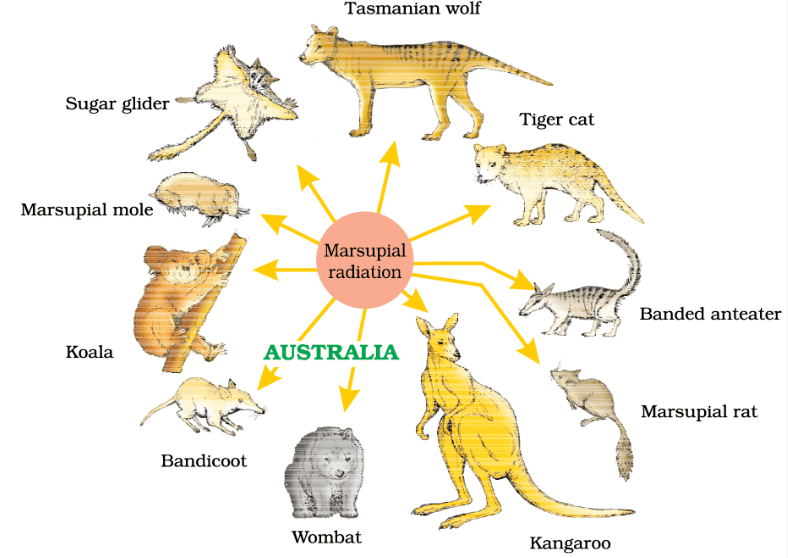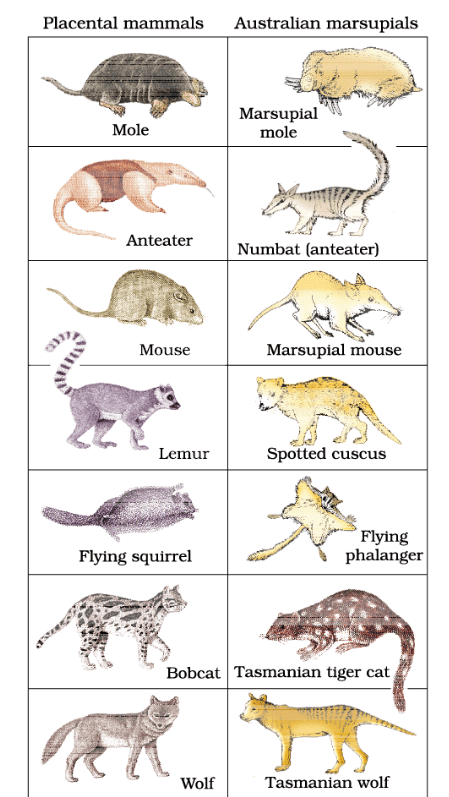Evidence of Evolution & Adaptive Radiation | Biology Class 12 - NEET PDF Download
| Table of contents |

|
| Evidence of Evolution |

|
| Similarities and Differences Among Organisms |

|
| Similarities in Proteins and Genes |

|
| Adaptive Radiation |

|
Evidence of Evolution
Evidence for the evolution of life forms on Earth comes from various sources, with fossils being a key indicator. Fossils are the remains of the hard parts of organisms found in rocks. The Earth's crust is made up of layers of sediments, and a cross-section of this crust shows how these sediments have been deposited over time.
 A family tree of dinosaurs and their living modern day counterpart organisms like crocodiles and birds
A family tree of dinosaurs and their living modern day counterpart organisms like crocodiles and birds
Different layers of rock contain fossils from different time periods, indicating that life forms have changed over time. Some fossils resemble modern organisms, while others belong to extinct species, such as dinosaurs. By studying the fossils in various sedimentary layers, scientists can determine the geological periods during which these organisms lived. This study reveals that life forms have varied over time and that new forms of life have emerged at different points in Earth's history. This evidence is known as paleontological evidence.
Fossils are remains of ancient organisms found in rocks, and they provide crucial information about the history of life on Earth. Rocks are formed from sediments, and a cross-section of the Earth's crust shows how these sediments have been layered over time.
- Fossils and Rock Layers. Different-aged rock sediments contain fossils of different organisms that likely died during the formation of that particular sediment. Some of these fossils resemble modern organisms, representing extinct species like dinosaurs.
- Geological Periods. Studying fossils in different sedimentary layers helps scientists determine the geological periods in which these organisms existed. This study shows that life forms varied over time and that certain organisms were restricted to specific geological timespans.
- New Forms of Life. The evidence indicates that new forms of life have arisen at different times in Earth's history. This process is known as evolution, where species change and adapt over long periods.
- Paleontological Evidence. The study of fossils and their distribution in rock layers is called paleontology. It provides strong evidence for the evolution of life on Earth and helps scientists understand the history of our planet.
Radioactive Dating of Fossils
- Radioactive-dating is a method used to determine the age of fossils by measuring the decay of radioactive isotopes within them.
- The principle behind this procedure is based on the known half-lives of certain radioactive isotopes, which decay at a predictable rate over time.
- By calculating the ratio of parent to daughter isotopes in a fossil, scientists can estimate how long it has been since the organism died and the fossil was formed.
Embryological Support for Evolution
- Ernst Heckel proposed that certain features observed during the embryonic stage of vertebrates support the idea of evolution.
- He noted that all vertebrate embryos, including humans, develop a row of vestigial gill slits just behind the head. These gill slits are functional organs in fish but are not found in the adult form of any other vertebrates.
However, this proposal was challenged by Karl Ernst von Baer, who conducted a careful study and found that embryos do not actually pass through the adult stages of other animals.
Similarities and Differences Among Organisms
Comparative anatomy and morphology help us understand the similarities and differences among organisms present today and those that existed in the past.
Homologous Structures and Divergent Evolution
 Example of homologous organs in (a) Plants and (b) Animals
Example of homologous organs in (a) Plants and (b) Animals
- Whales, bats, cheetahs, and humans (all mammals) have similar bone structures in their forelimbs, including the humerus, radius, ulna, carpals, metacarpals, and phalanges.
- Despite serving different functions, these forelimbs share a common anatomical structure, indicating divergent evolution.
- This suggests that these animals share a common ancestor, and the same structure evolved in different directions due to adaptations to different needs.
- Other examples of homologous structures include vertebrate hearts and brains.
- In plants, the thorns and tendrils of Bougainvillea and Cucurbita also represent homology.
Analogous Structures and Convergent Evolution
- Analogous structures, on the other hand, result from convergent evolution, where different structures evolve for the same function, leading to similarity.
- For example, the wings of butterflies and birds are analogous because they perform similar functions but have different anatomical structures.
- Other examples of analogy include the eyes of octopuses and mammals, as well as the flippers of penguins and dolphins.
- These similarities arise from similar habitats leading to the selection of similar adaptive features in different groups of organisms.
Analogy
Potato: stem modification (tuber) used for storage, Sweet Potato:. root modification (storage root) used for storage. Both serve as food sources, but one is a modified stem while the other is a modified root.
Similarities in Proteins and Genes
- Common Ancestry: Similar proteins and genes performing the same function in different organisms suggest a common ancestor.
- Biochemical vs. Structural Similarities: Just like structural similarities, these biochemical similarities point to shared ancestry.
Artificial Selection by Humans
- Selective Breeding: Humans have bred plants and animals for various purposes such as agriculture, horticulture, sports, and security.
- Domestication: Many wild animals and crops have been domesticated by humans.
- Creation of Breeds: Intensive breeding has led to the creation of different breeds within the same group, like dogs.
- Natural Evolution: If humans can create new breeds in hundreds of years, nature could do the same over millions of years.
Case Study: Moths in England (Industrial Melanism)
 Figure showing white - winged moth and dark - winged moth (melanised) on a tree trunk (a) In unpolluted area (b) In polluted area
Figure showing white - winged moth and dark - winged moth (melanised) on a tree trunk (a) In unpolluted area (b) In polluted area
- Pre-Industrialisation (1850s): More white-winged moths were found on trees.
- Post-Industrialisation (1920): The proportion of dark-winged moths increased, showing a reversal.
- Evolution by Natural Selection: This change in moth populations supports the idea of evolution by natural selection.
- Predation and Camouflage: The survival of moths depends on their ability to blend in with their background. Predators are more likely to spot a moth if it contrasts with its surroundings.
- Pre-Industrial Era: Before industrialization, tree trunks were covered with light-colored lichen, providing a suitable background for white-winged moths. In this environment, dark-winged or melanized moths were easily spotted by predators.
- Post-Industrial Era: With industrialization, tree trunks became dark due to smoke and soot. In this changed environment, white-winged moths could not survive because they were more visible to predators, while dark-winged moths thrived.
- Lichens as Pollution Indicators: Lichens are sensitive to pollution and will not grow in contaminated areas. This fact supports the idea that moths survived by adapting to their changing environment.
- Adaptation and Survival: The examples of the moths illustrate that in a mixed population, those who can adapt better to their environment will survive and increase in number. No variant is completely eliminated.
- Anthropogenic Evolution: The excessive use of herbicides, pesticides, and antibiotics has led to the rapid selection of resistant varieties. This process is much faster than in the past and is an example of evolution caused by human actions.
- Stochastic Nature of Evolution: Evolution is not a directed or predetermined process. It is based on chance events in nature and random mutations in organisms.
Adaptive Radiation
 Adaptive radiation of marsupials of Australia
Adaptive radiation of marsupials of Australia
Darwin's Observations
- During his journey, Darwin visited the Galapagos Islands and noticed a remarkable diversity of creatures.
- He was particularly fascinated by small black birds known as Darwin's Finches.
 Variety of beaks of finches that Darwin found in Galapagos Island
Variety of beaks of finches that Darwin found in Galapagos Island
Evolution of Finches
- Darwin observed many different varieties of finches on the same island and suspected that they all evolved there from a common ancestor.
- He believed that these finches started with seed-eating beaks and then developed various other beak shapes that allowed them to eat insects and plants.
Concept of Adaptive Radiation
- Adaptive radiation refers to the process where different species evolve from a common ancestor in a specific geographical area, adapting to various habitats.
- Darwin's finches are a prime example of this phenomenon.
Example of Australian Marsupials: Various marsupials in Australia evolved from a common ancestral stock, each adapting to different environments on the continent.
 Picture showing convergent evolution of Australian Marsupials and placental mammals
Picture showing convergent evolution of Australian Marsupials and placental mammals
Convergent Evolution
- When multiple instances of adaptive radiation occur in an isolated geographical area, representing different habitats, it is referred to as convergent evolution.
- For example, placental mammals in Australia evolved into varieties that resembled marsupials, such as the placental wolf and the Tasmanian wolf-marsupial.
|
59 videos|290 docs|168 tests
|
FAQs on Evidence of Evolution & Adaptive Radiation - Biology Class 12 - NEET
| 1. What is adaptive radiation? |  |
| 2. What are some examples of adaptive radiation? |  |
| 3. How does adaptive radiation occur in urban environments? |  |
| 4. What evidence supports adaptive radiation in evolution? |  |
| 5. How can studying adaptive radiation benefit conservation efforts? |  |





















